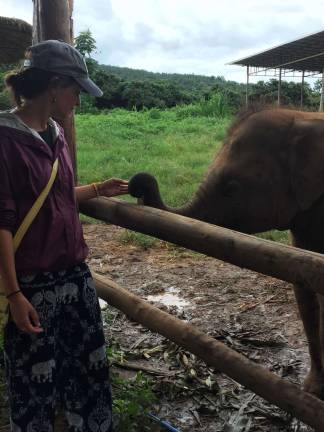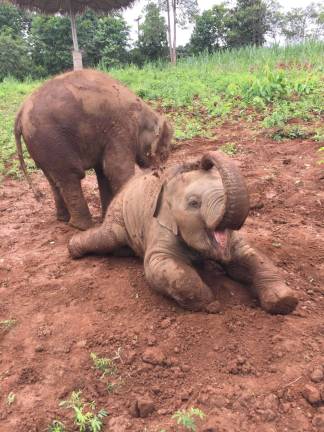Walking with (not riding on) elephants


About an hour’s drive southwest of Chiang Mai, Thailand, my high school students and I climbed out of two vans at an elephant park. We had just spent two weeks teaching English at primary schools in Chiang Rai, the city made famous by the boys who were rescued from the cave just days before my students arrived. Our teaching weeks complete, the last day of our trip was set aside for the elephants.
We gathered on the patio of Elephant Freedom I, a satellite campus of the well-known Elephant Nature Park, to receive instructions from our guide, stealing glances at the elephants in a paddock 20 yards away. Soon enough, we headed to the fence with huge bucketsful of bananas.
Three adults and two babies (eight months and 11 months) waited impatiently for their breakfast. One of the baby elephants climbed over the low fence to get at the bananas sooner. We held out the bananas, two or three at a time, and the elephants curled the tips of their trunks around them, then fed them into their mouths, extending their trunks towards us again before we even had time to pick up more bananas. Their trunks felt rough, their thick skin moist. The adults ate the bananas peels and all, but we peeled them for the babies, who couldn’t yet swallow them whole. The babies’ trunks were also less dexterous, and they often dropped their bananas in the mud, like any human baby making a mess while learning to feed itself.
Adult elephants eat up to 660 pounds of food a day, so after the bananas were gone (this didn’t take long), the mahouts, or elephant tenders, let the elephants out of the paddock and we walked with them to a semi-forested area where they could forage. Following an elephant down a forest path is an experience few have, even in touristy circumstances like this. That’s what makes Elephant Nature Park special.
Sangdeaun Lek Chailert, a now internationally recognized animal rights advocate, began the park in 1995 with four elephants; now 83 elephants live there. Elephant Nature Park is a saddle-off park, which means that none of the elephants who live there are ever ridden by humans. Elephants rescued from riding camps sometimes arrive at the park with broken legs or hips, blind from cataracts or injuries, or missing limbs from land mine explosions. Injured and orphaned elephants are cared for, and visitors to the park interact only with the elephants in good health.
At satellite campuses of the park, like the one we visited, Elephant Nature Park has partnered with local families that own elephants. Hill Tribe families in Thailand have traditionally used elephants for their livelihoods through riding and trekking tours, so taking elephants away from these families would take away their main source of income. Instead, Elephant Nature Park works with these families to create experiences that help keep the elephants healthy and happy and that provide income to support the local people.
The elephants momentarily satiated, we took our turn to eat lunch, and afterwards, we walked with the elephants again, this time to the river. Once we got there, the elephants entered the water knee-deep, then lay down in the water as we splashed them with buckets. The babies wrestled, taking turns dunking each other under the water. Everyone was soon drenched, the cool water delightful in the humid northern Thailand weather. My students screamed and laughed and splashed, reveling in the opportunity to be close to these wise giants.